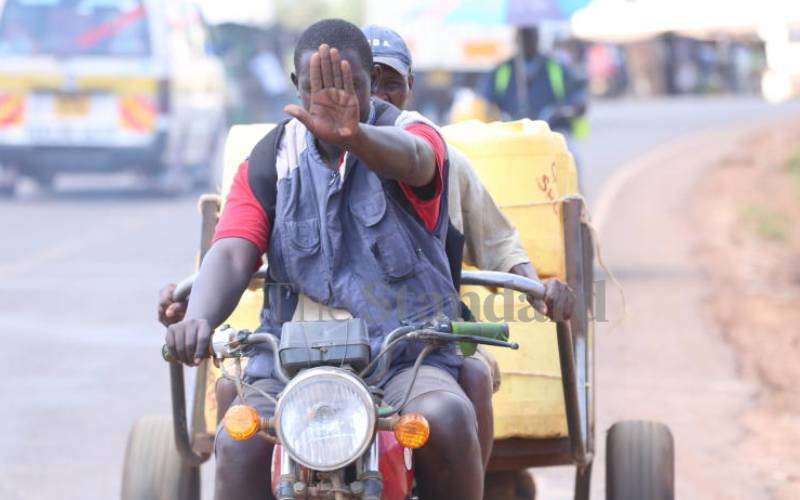By Gakuu Mathenge
The battle for Nakuru Town has split politicians across the political divide and is now assuming the profile of one of the most contentious issues in the Proposed Constitution.
The Standard On Sunday has established disagreements over how to deal with Nakuru Town, and satisfy the Kalenjin and Kikuyu communities in the Rift valley escalated to become the most divisive issue that sunk the four-day Kenya Institute of Administration (KIA) constitutional talks last week.
It is one of the knotty issues that are being singled out for stalling progress in the devolution debate.
"The Kikuyu see a plot similar to the British scheme to split and scatter the Kurdish community into Iraq, Iran and Turkey where their status changed from majority to minorities. The Kalenjin are talking about an attempt by the Kikuyu to ‘grab’ their traditional commercial and political capital of Nakuru," a source close to the KIA discussions said.
The dispute has sucked in all major political players: ODM is rooting for the retention of three-tier government while PNU wants a two-tier system of national and county governments.
Political capital
In between are Agriculture Minister William Ruto and Finance Minister Uhuru Kenyatta.
Ruto’s supporters want to retain authority over the town as their political and commercial capital, but which Uhuru supporters resist. Ruto and Uhuru have lately forged an alliance.
"Our position right now is that the Proposed Constitution should pass as it is, with the 47 counties that recognise Nakuru as a county. Anything short of this, we have resolved and communicated as much, we will not participate in debate in Parliament or referendum," Naivasha MP John Mututho said in an interview.
Mututho and colleagues Joseph Kiuna (Molo), Lee Kinyanjui (Nakuru Town), Nelson Gaichuhie (Subukia), Nderitu Muriithi (Laikipia West) and Mwangi Kiunjuri (Laikipia East) last week warned they would mobilise their constituents against the draft if Laikipia and Nakuru counties are not left intact.
Matters came to ahead after a group of Rift Valley MPs are reported to have loudly declared they would resist proposals that do not locate Nakuru in their region.
Disagreements at KIA led to legislators caucusing as regions, as opposed to parties with leaders from various regions looking at what they would ‘gain or lose’ in various proposals.
The regional and ethnic caucusing on devolution debate was informed by the anticipated devolution of resources to the regions, counties and constituencies in the Proposed Constitution.
The regions proposal, that retains the current provincial boundaries, and attendant regional political and ethnic identities as opposed to proposed counties that delete the present provincial boundaries, is one of the issues MPs are yet to agree on.
The Kalenjin MPs strongly supported a proposal for 25 regions, among them Central Rift, which lumps together Nakuru, Molo, Subukia, Kuresoi, Rongai and Naivasha constituencies with Old Kericho, Bomet and Baringo districts.
This is contrary to proposals in the CoE Draft that placed these constituencies in the proposed Nakuru county.
The regions proposal also projected to delete the proposed Laikipia county and instead merge Laikipia West and East with the Western Rift Valley region that brings together Samburu, Baragoi and Laisamis districts.
This proposal did not go down well with MPs from Laikipia and Nakuru, and who accused by their Kalenjin counterparts of plotting to scatter the Kikuyu vote in the Rift Valley into different counties to make them a minority in the proposed central and Western Rift Valley regions.
Initially, sources say, Uhuru had supported the 25 regions backed by Ruto, but had not envisaged the backlash from the Kikuyu diaspora.
Oppose move
Sources say the Kikuyu in Diaspora representatives met senior PNU leaders, including Uhuru, Internal Security Minister George Saitoti, Energy Minister Kiraitu Murungi at KIA, where they threatened they would vote against the Proposed Constitution if the 25 regions reduce the Kikuyu vote into a minority in Rift Valley by scattering into different regions.
On the other hand, the Kalenjin MPs insisted they would oppose any proposal that denies them political authority over Nakuru.
Rongai MP Luca Kigen believes central Kenya MPs are not being sincere.
"The Kikuyu MPs feel threatened by the proposed central Rift Region because they fear they would lose leadership and voting power to elect senators. They want to stick to the Nakuru senate, which gives them political advantage because they control six constituencies — Nakuru Town, Subukia, Molo and Naivasha. The Kalenjin have Rongai and Kuresoi.
Regions and counties are essentially economic entities and all sides want to control Nakuru, which is already a developed entity," said Kigen.
The proposed 47 counties are based on the 1992 district boundaries, while the proposed regions in Rift Valley will include Northern, Southern and Central Rift.
"We could not agree at KIA, no meaningful agreement could be reached without compromises and the talks collapsed. It is true Nakuru is the headquarters of Rift Valley Province and the Kikuyu and Kalenjin drive many events in Nakuru. One of them has to climb down for a compromise to be reached," he said.
 The Standard Group Plc is a multi-media organization with investments in media
platforms spanning newspaper print operations, television, radio broadcasting,
digital and online services. The Standard Group is recognized as a leading
multi-media house in Kenya with a key influence in matters of national and
international interest.
The Standard Group Plc is a multi-media organization with investments in media
platforms spanning newspaper print operations, television, radio broadcasting,
digital and online services. The Standard Group is recognized as a leading
multi-media house in Kenya with a key influence in matters of national and
international interest.
 The Standard Group Plc is a multi-media organization with investments in media
platforms spanning newspaper print operations, television, radio broadcasting,
digital and online services. The Standard Group is recognized as a leading
multi-media house in Kenya with a key influence in matters of national and
international interest.
The Standard Group Plc is a multi-media organization with investments in media
platforms spanning newspaper print operations, television, radio broadcasting,
digital and online services. The Standard Group is recognized as a leading
multi-media house in Kenya with a key influence in matters of national and
international interest.









